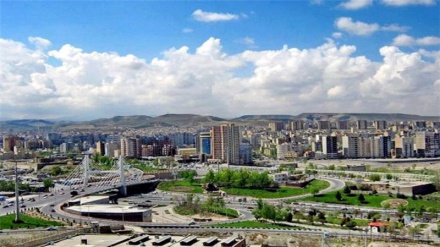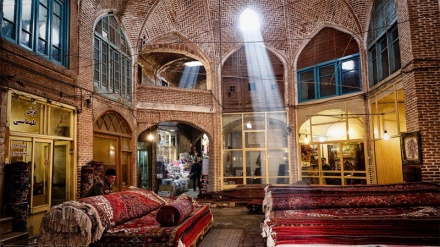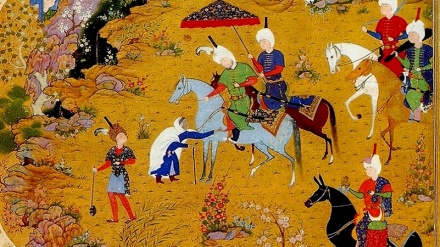Tabriz, 2018 (15)
Welcome to this week's episode of the series "Tabriz, 2018". Today, we become familiar with the Poets' Cemetery in the city of Tabriz, and a number of poets, who have been laid to rest in this cemetery.
The Poets' Cemetery is one of the historical cemeteries of the city of Tabriz, within which more than 400 renowned and pre-eminent poets of the history of Iran's literature have been laid to rest. The poets who have been buried in this cemetery include Khaqani, Asadi Tousi, and Shahriar.
Meanwhile, the poets' cemetery was initially mentioned in a book of history which was compiled throughout the years 730 AH to 740 AH.
This cemetery has apparently become well-known after the burial of some of the famous poets of 6th Century AH, such as Khaqani and Zahir in it. As of 6th Century AH, the city of Tabriz sheltered poets, who sought a peaceful life, far from battles and confrontations. Khaqani, Zahir, and Shahpour khorasani, migrated to, and settled in the city of Tabriz, and were later buried in the Poets' Cemetery.
The Poets' Cemetery was previously known as Sorkhaab Cemetery. With the passage of time, and due to occurrence of natural disasters, such as floods, and earthquakes, the apparent shape of this cemetery gradually faded away, and no trace of the tombs of some of these renowned poets, remained.
In the year 1971, given the presence of the tombs of numerous well-known mystics and poets in this cemetery, the then government decided to reconstruct this graveyard, while staging a competition for the renovation of this cemetery, and construction of its memorial building. The construction of the memorial building of this cemetery was carried out as of 1972 till 1982. Thereafter, the Ministry of Culture and Islamic Guidance took charge of this project. Based on this project, plans were made for construction of a cultural complex for the gathering of artists and art-lovers in this venue, in addition to construction of a memorial building in this complex. This 11,000-square meter historical and cultural complex was to include a cemetery, a museum, an exhibition, and a pavement which aimed to connect different historical sections of this cemetery. In the meantime, the final project of the Poets' Cemetery in the city of Tabriz has not been fully implemented.
The core of this structure is metallic in nature, which has been covered with concrete pieces. The structure manifests a blend of modern and traditional architecture and has been designed in a manner which enables the viewer to form an instant bond with the freshness of its design. The aim of this project has been to maintain the architectural attraction of this structure, irrespective of the passage of time.
In the meantime, the intertwined arcs of the Poets' Cemetery in the city of Tabriz draws the attention of all viewers.
The main building of the Poets' Cemetery Complex is more than thirty meters in height, and has turned into a symbol and epitome of the identity, arts, and culture of the city of Tabriz, throughout the years. Upon entering this cemetery, and climbing up the stairs, you observe a huge building, which has been constructed with full precision and artistic delicacy; with the building's magnificent, intertwined arcs astounding every single viewer. In order to reach the gateway of the building, you have to go down the stairs, to reach the lower section of this memorial building. The main venue of the memorial building of Poets' Cemetery is comprised of a large chamber, which is next to a number of smaller chambers. Among all of the existing tombs, one tomb is situated round the corner of the chamber, which captures the attention of newcomers. This is the tomb of well-established contemporary poet, Shahriar, whose poems in Farsi and Azari languages are highly familiar for enthusiasts of Farsi literature.
The chamber's walls are surrounded with the poems of renowned poets, who have been laid to rest in this cemetery; granting additional beauty and charm to the cemetery.
Now, let's become familiar with a number of acclaimed poets which have been laid to rest in Poets' Cemetery.
Abu Nasr Ali ibn Ahmad Asadi Tousi has been buried in this cemetery. He was well-known for his long odes; some of which have remained to this day. This famed poet was originally from the city of Tous, in Khorasan region, however, he passed away in the city of Tabriz in the year 425 AH.
Khaqani is one the best known poets, who have been laid to rest in this cemetery. He is considered as the best known poet of 6th Century AH. He was born in the city of Shirvan. In accordance with historical sources, this well-known poet was born in the year 520 AH and passed away in the year 595 AH in Tabriz. He has left behind a number of works, including his collection of poems.
Qatran Tabrizi was one of the famed poets of 5th Century AH, who has been buried in Poets' Cemetery. He is the first poet of Azarbaijan region of Iran, who composed poems in Farsi language. His works include his collection of poems. He passed away in the year 425 AH. The importance of his works is because of their reference to the important historical events of the city of Tabriz.
Mohammad Hossein Behjat Tabrizi, known by his penname, Shahriar, is one of the best known poets, who have been buried in Poets' Cemetery in the city of Tabriz. Born in 1325 AH in Tabriz, he migrated to Tehran at a young age in order to continue his studies. Upon entry to Tehran, he became acquainted with the famed musician, Abul-Hassan Saba, learning how to play the musical instrument, Setaar, from this well-established musician. Shahriar also continued his religious studies, while entering the school of medicine later on. During his years of presence in Tehran, Shahriar skillfully composed poems in Farsi and Azari languages, turning into a well-known poet.
In the year 1953, he dropped out of the school of medicine and returned to Tabriz. In that year, he got married, and later had three children. In the 1960s, he shot to fame, with his collection of poems in Farsi and Azari languages, being republished on several occasions. Ultimately he became ill and passed away in the year 1988. Based on his will, he was laid to rest at Poets' Cemetery in Tabriz.
Based on the approval of the High Council for Cultural Revolution, the anniversary of demise of the famed Iranian poet, Shahriar, was named as the National Day of Farsi Poetry and Literature. Hence, on this occasion, commemoration events are held across Islamic Iran to honor this highly skilled Iranian poet, and to praise the elevated status of Iranian poetry and arts.
MR/ME


